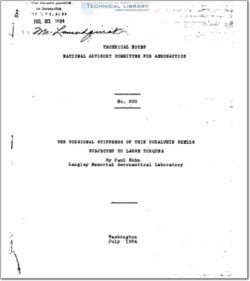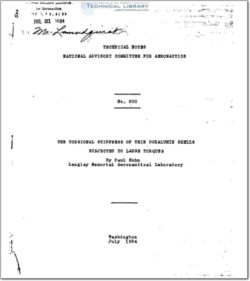naca-tn-500

- Version
- 249 Downloads
- 882.03 KB File Size
- 1 File Count
- April 23, 2016 Create Date
- April 23, 2016 Last Updated
National Advisory Committee for Aeronautics, Technical Notes - The Torsional Stiffness of Thin Duralumin Shells Subjected to Large Torques

This report gives a simple method of estimating the
torsional stiffness of thin shells. such as ho: beams or
stressed—skin wings under large torque loads. A general
efficiency chart for shells in torsion is established,
based on the assumption that the efficiency of the web
sheet in resisting deformation decreases linearly with
the average stress. The chart is used to calculate the
torsional deflections of eight box beams. a test wing pan-
el, and a complete wing; the results of the calculations
are shown in comparison with the test results. The agree-
ment is probably as good as might be expected _consfderi_ng
the empirical nature of the method and the well— known dis—
persion between results of tests on thin sheet-metal
structures.
A knowledge of the torsional st_iffness of box beams
and stressed—skin wings under large tor_sional moments is
necessary for calculating the interaction between spars
(reference 1).. Thin shells of this nature buckle under
small loads and the cover plates work no longer in shear,
but in diagonal tension. This transition decreases the
torsional stiffness considerably. but it is not sufficient
to explain the large deformations that tests show, partic—
ularly under large loads. The experimental load-deforma-
tion diagrams are carves rather than straight lines indi-
cating that the torsional stiffness decreases centinuous-
1y as the load increases. A method of correcting the
theoretical-stiffness constants was therefore developed
based on the assumption that the efficiency of the sheet
metal in resisting deformation decreases linearly with
the average stress in the sheet, the rate of decrease de-
pending on the aspect ratio of the individual sheets.
Box spars and stressed-skin wings are also thin—
walled tubes, but the wall thicknesses are very much
smaller in relation to the dimensions of the cross section
than in the case of tubing. When such a thin shell is
subjected to torsion. the sides will buckle at a very
small load and will be transformed into diagonal—tension
field beams.
| File | Action |
|---|---|
| naca-tn-500 The Torsional Stiffness of Thin Duralumin Shells Subjected to Large Torques.pdf | Download |

Comment On This Post